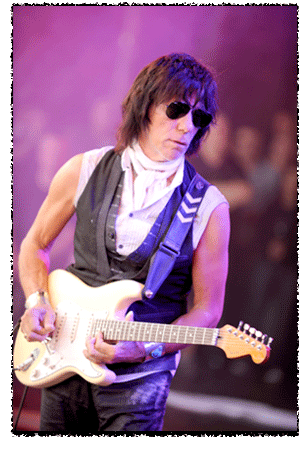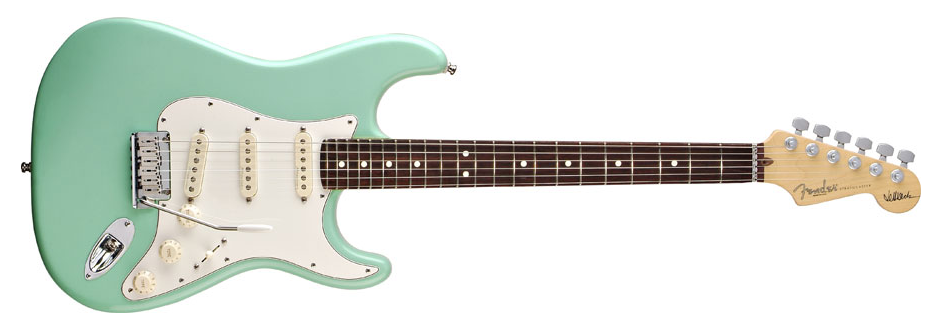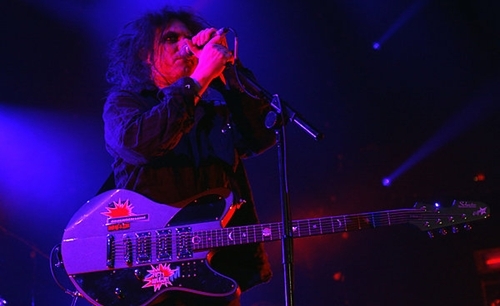I thought this video was appropriate after my Jeff Beck post. Stevie Wonder’s band is amazingly tight, quite an example for us mere mortals:
Tag Archives: Guitarists
Guitarists: the tone and style of Jeff Beck
I don’t think Jeff Beck needs any introduction, he is one of the inventors of rock guitar, has traded licks with everybody and, more importantly, is one of the most original rock guitarists out there.
We will see in this post how we can emulate his tone using simple effect pedals and talk about his style. If you are unfamiliar with Jeff Beck, I advise you to start with his “Live at Ronnie Scotts” released in 2008, this is Jeff Beck on stage at his best, truly amazing music.

Jeff Beck to me is the perfect example of the fact that the tone is in “your fingers”. Granted, you need a bit more than your fingers to create a guitar tone but let’s say that in the case of Jeff Beck, the gear is really not more than half of his tone. Some people say he is a walking multi-effect unit and there is some truth in that. However, we will see that his choice of gear allows him to use all his sound tricks and amazing technique.
Guitars
Although he has used a lot of different guitars over the years including Les Pauls and Telecasters, Jeff Beck has been associated with the Fender Stratocaster for a good 30 years now. He exploits all of the tonal capacities of the Stratocaster: use and abuse of the tremolo arm, brightness of the bridge pickup, mellowness of the neck pickup, swells using the volume knob, slapping, etc.

It is also interesting to see that like his fellow brit Eric Clapton, Jeff Beck has had his own Stratocaster signature model since the 80s and this signature model has changed over the years. I remember drooling over first Jeff Beck models equipped with lace sensor pickups, including a curious humbucker in the bridge position. Nowadays, the Jeff Beck Stratocaster model features Fender noiseless pickups and a modern LSR roller nut tremolo system.
Amps
Jeff Beck is quite partial to good old Marshall amps. I had the chance to see him live in Paris in 2001 and he was using JCM 2000 DSL 100 stack amps. It is a configuration he used for most of the last decade. The gear heads have noticed that for his “Live at Ronnie Scotts” in 2008 and subsequent live appearances, he seems to have been using a Marshall JTM-45 head and a Vintage Modern one. Jeff Beck’s overdriven tone has definitely a Marshall quality to it. Check out this video of Jeff Beck’s guitar tech for more information about his amp settings. According to him, most of the tone heard on the “Live at Ronnie Scotts” comes from the JTM-45, with the bass totally rolled off and a lot of the EQing is done right from the guitar, using the tone control. On this topic, normal stratocasters do not have a tone control for the bridge pickup but the Jeff Beck model has a general tone control and a TBX control.
Effects
Jeff Beck, throughout his career, has been using very few effects between his guitar and his amp. He was famous for using the Proco Rat distortion in the 80s and also a flanger at some stage during that period. When I saw him in Paris in 2001, I only saw a wah pedal between his guitar and his amps. For the live at Ronnie Scotts and subsequent live appearances he has been spotted using a quite rare and expensive Klon Centaur overdrive pedal to get more overdrive (or maybe to make up for the fact that the JTM-45 has less distortion than a more recent Marshall amp).
Now where it gets tricky is that it is not because he does not have many pedals between his guitar and amps that he does not use any effect. Actually if you listen to any of his studio recordings, there is clearly quite some reverb added to the guitar sound and often some delay too, making it very spacious. When I saw him live, I could clearly hear quite some delay and/or reverb added at the mixing console. On a side note, the amount of reverb one would require in a live situation depends on the venue – no need for a reverb if you play in a church for instance.
During the “Live at Ronnie Scotts” show, you can see from the DVD footage that a Lexicon ALEX reverb unit is stacked on one of his amps and people have clearly witnessed Jeff Beck manipulating it during the show. It is speculated that Ronnie Scott’s being a small-ish venue, Jeff Beck brought his own reverb to create the spacious tone he is known for. Now did this reverb unit fit exactly in the chain, it is a mystery to me although we can suppose it was either in the loop of the Vintage Modern head or between the overdrive and the JTM-45, or perhaps it was connected to the console and was affecting the sound of the miked amps.
Let’s recreate Jeff Beck’s tone
To recreate Jeff Beck’s tone, I have deliberately decided to use one of the most common and cheapest overdrives on the market, the BOSS SD-1, plugged into a clean amp. I want to show that you don’t need a monster Marshall amp to create an impression of Jeff Beck’s tone, just a good overdrive or distortion pedal. An SD-1 will be closer to the tone of his earlier works, I have the feeling he uses more gain these days.
I have also decided to add a BOSS RV-3 reverb to give quite some spaciousness to the tone and that’s it. One overdrive, one reverb… and a Fender Stratocaster of course. My Stratocaster is an American Classics Custom Shop model equipped with noiseless pickups from Kinman. It features a “normal” tremolo system and I must say it was difficult to remain in tune while abusing it.
To sound more like Jeff Beck, it is not really the gear that does it, the hardest is to emulate his numerous techniques right on the guitar (check out my video):
- first and foremost use of the fingers instead of a plectrum
- slapping: Jeff Beck often pulls the string the same way a bass player does when slapping, it is very effective on a strat to create a percussive kind of tone
- volume swells: use of the volume control on the guitar to suppress the attack of the notes and thus create a “violin” like sound
- use of the volume knob to control the amount of dirt in the tone
- tremolo arm: either for gentle vibrato or more drastic effects, Jeff Beck is one of the top masters at using the tremolo arm
- use of different pickups: the bridge pickup for brightness, the neck pickup for mellowness
This is just to name a few. I have created a video to show some of the different techniques (this is a rather bad piece of music in itself I realize it, but this is not the point 😉 ):
The settings were as follows:
- On the Champ: Volume 2.5, Bass 10 Treble 2
- On the SD-1 : Gain on full, tone at 9 o’clock and level at 1 o’clock
- On the RV-3: Mode Hall, Balance at 1 o’clock, tone at 10 o’clock, Time at 1 o’clock
It was recorded with a Boss Micro-BR, miked with a shure SM-57 and mixed in Cubase 5, bits of compression were added to the guitar and the overall mix.
Finally, here is a short sample showing the basic clean sound I have used augmented first by the BOSS SD-1 and then the RV-3 Reverb:
[audio:http://www.guitartoneoverload.com/audioHIDDENZZZZ/JeffBeckFX.mp3|titles=Jeff Beck FX Before and After]
Jimi Hendrix is back (kinda): Valleys of Neptune
Being one of the biggest fans of Jimi Hendrix on earth, I had to post about the upcoming posthumous album entitled “Valleys of Neptune”.
It features twelve never released before titles and is coming out on March 9th. The video for the title song can be seen here or on www.jimihendrix.com. Did you say psychedelic?
Guitarists: Robert Smith of The Cure
I could have started this series about guitarists by featuring a fast heavy metal guitar slinger (and believe me, I love them) but instead I have decided to scrutinize the style and tone of The Cure‘s Guitarist: Robert Smith. We will also see how we can reproduce his tone using some common pedals.

The Cure formed in 1976 as “the Easy Cure” to be renamed “The Cure” two years later. Characterized by a dark sound and gloomy lyrics, it was at the forefront of a movement labeled as new wave alongside acts such as Joy Division. The Cure is still in activity today and released an album (4:13) in 2008. Although the line up has changed constantly through the years, guitarist/singer Robert Smith has been a constant in the band (alongside bass player Simon Gallup) and the main writer/composer. Look here for a complete biography of the band.
As a guitarist, Robert Smith is very much into creating atmospheres using various modulation effects as well as delay. Starting with the disintegration album released in 1989, the Fender Bass VI, a baritone guitar, became an essential part of his sound and he is one of the rare users of the instrument in the realm of rock.
But I will focus here on an album which, to me, defined The Cure sound: Seventeen Seconds released in 1980. In particular, this album features ‘A Forest’. This song was so influential in the 80s that I remember it being the very first song I ever played in a band (I was playing the keyboards at the time and was shockingly bad at it).
The production of ‘A Forest’ is explained in details in the December 04 edition of Sound on Sound Magazine. What is particularly interesting in this article is the fact that the base of the guitar sound was a Fender Jazzmaster plugged into a Roland JC-120 whose built-in stereo chorus and clean tone was captured using two microphones. On top of that, a lot of outboard effects (flanger, delays and reverb) were used to create that very atmospheric sound. At the beginning of the song, the guitar sound is fairly dry, only some modulation is present and towards the end more delay is introduced.
This pattern is reproduced in this quite early live rendition and Robert Smith uses pedals to reproduce the studio tone:
There are plenty of versions of this song on youtube and you’ll notice that in the more recent versions, the guitar tone is even more modulated and that quite some delay is added.
Let’s try to reproduce this particular tone using these simple pedals (the makeup and the hairdo are optional but they help in getting the tone right):
- A Boss BF-2 Flanger (now replaced by the BF-3 but easy to find on the second hand market). The settings were manual 60%, Depth 75%, Rate 50% and Res 25%.
- A Boss DD-3 Delay: all knobs more or less at 50%.
- A Boss RV-3 Reverb (discontinued too and replaced by the RV-5): balance 25%, tone 30%, r.time 40%, mode 10.
Of course, other brands than BOSS are fine to emulate Robert Smith’s tone as long as you have a good chorus or flanger (a flanger is preferable but a strong chorus can do the trick) but the man himself uses a BF-2 (he actually has been using the whole Boss modulation/delay collection over the years).
In these examples, I use a Fender Custom Shop American Classic Fender Stratocaster from 1997. It is equipped with noiseless Kinman pickups (the av-n blues set) and plugged into a Marshall JMP-1 preamp set clean (channel “clean 1”, gain 9) and plugged straight into the recorder, a Boss MICRO-BR. The drums are provided by the drumbox built in the recorder.
Guitar only first (first part is clean, second part has the BF-2 flanger on, third part has the Boss DD-3 delay and the flanger on):
And now an attempt to capture the atmosphere (I have played the intro followed by a kind of improv) :
